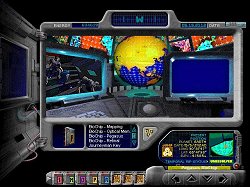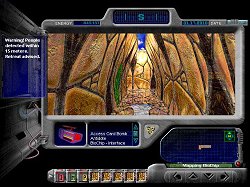|
Journeyman Project (Turbo)
 I have had all three parts of the Journeyman saga on my shelf for some time, and have always intended to play them in order. Well, now I have played the first, and its safe to say that whilst I will certainly play the other two, I wouldn't have missed terribly much if I had skipped this one.
I mean that quite literally. It took me four hours maximum with a short break or two, and about a quarter of that was taken up with video or motion sequences that I just watched. Another quarter was spent dying and restoring, which meant there was probably two hours of actual game play. As I said, I wouldn't have missed much.
What there is is not bad, just ordinary. I have had all three parts of the Journeyman saga on my shelf for some time, and have always intended to play them in order. Well, now I have played the first, and its safe to say that whilst I will certainly play the other two, I wouldn't have missed terribly much if I had skipped this one.
I mean that quite literally. It took me four hours maximum with a short break or two, and about a quarter of that was taken up with video or motion sequences that I just watched. Another quarter was spent dying and restoring, which meant there was probably two hours of actual game play. As I said, I wouldn't have missed much.
What there is is not bad, just ordinary.
You are an agent (I never learned my name only my number) for the Temporal Protectorate, the guardians of time, and you will need to travel back in time from the year 2318 to fix three separate rips in the fabric of time to ensure the proper course of history. What needs to be accomplished to restore history is up to you to determine when you get there. Having repaired the rips, you must then find and neutralise the source of those rips.
The game is played using the fancily named BioTech Interface model SL1772. Described as "a monocle which covers the left eye", it results in a game play window of quite small dimensions, the rest of the screen being taken up with all the associated buttons and readouts of the Interface. You have a rack of collected BioChips, an inventory display, a digital compass, date display, an energy level indicator, a readout of the selected BioChip, inventory controls, and an AI module that provides information and warns of imminent danger.
 It's all quite simple, if a bit cluttered, but a larger game play window would have been preferable (the graphics are actually quite good, allowing for its age). It is however in keeping with the high-tech nature of proceedings.
You can move around using the arrow keys on the keyboard, or by mouse clicking on movement buttons (I forgot to mention those) on the Interface. If you walk into a wall, or other object, you get an appropriate grunt.
Despite the vast array of buttons and displays, I used very few. Some BioChips are necessary to achieve certain objectives, but the button I primarily used was the one to save and restore. I did die quite often, usually because I didn't know that going somewhere or interacting with some item was deadly. You also have to stay out of the way of the locals, a prime time travel rule, and the game will end if you disobey. It's all quite simple, if a bit cluttered, but a larger game play window would have been preferable (the graphics are actually quite good, allowing for its age). It is however in keeping with the high-tech nature of proceedings.
You can move around using the arrow keys on the keyboard, or by mouse clicking on movement buttons (I forgot to mention those) on the Interface. If you walk into a wall, or other object, you get an appropriate grunt.
Despite the vast array of buttons and displays, I used very few. Some BioChips are necessary to achieve certain objectives, but the button I primarily used was the one to save and restore. I did die quite often, usually because I didn't know that going somewhere or interacting with some item was deadly. You also have to stay out of the way of the locals, a prime time travel rule, and the game will end if you disobey.
The puzzles are very simple, although some have an arcade-like quality to them. My recollection is that all of them are timed, but only once did I run out of time, an indicator primarily of their ease. You can also only spend a certain amount of time in the past before having to jump back to the present, but again I never had to do so, repairing the rip well and truly before my energy levels ran out.
You get points as you go and as you find items, and each mission back in time can be completed in a peaceful or not so peaceful way. You get a "Ghandi" bonus if you complete them all peacefully, and extra points will also be given based on the number of attempts taken, the energy used and so on.
The "turbo" in the title comes from the fact that the original 1992 release was given a 'tarting' up, particularly in terms of speed, and re-released in 1994 claiming to be 300% faster (hence turbo). I can't comment how much faster it is but this version ran quite ok.
I like time travel as a concept, and enjoy the paradoxes and conundrums that fiddling with time presents. I trust the next two instalments of the Journeyman saga will offer a bit more of everything than this outing.
Copyright © Steve Ramsey 2002.
All rights reserved.
System Requirements:
Windows 3.1 or higher, 386/33 MHz or higher, 4 MB RAM, CD ROM, SuperVGA Monitor, 256 colours..
|
